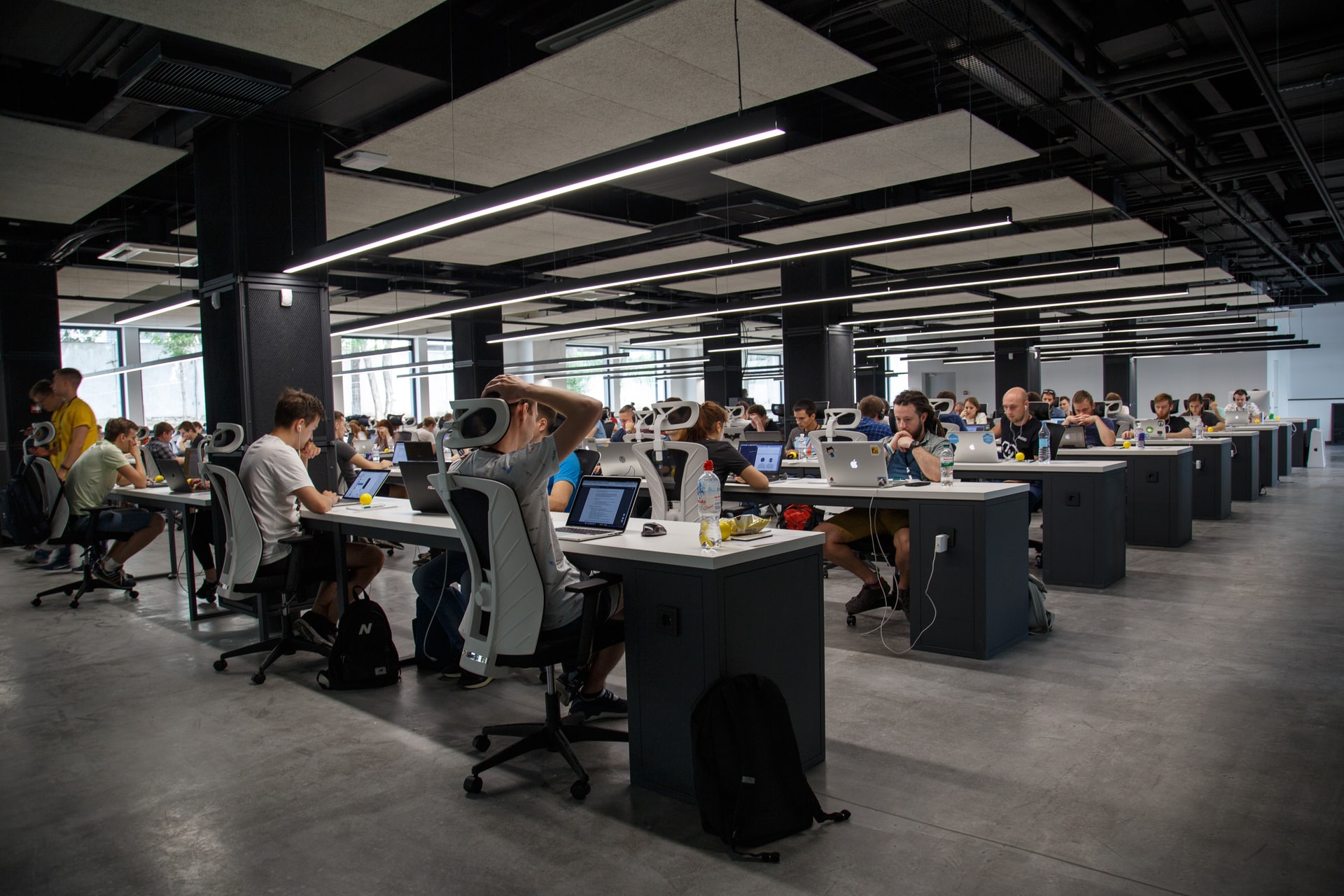“I’m working” can mean a lot of things.
You might be working on a strategy document with the door shut. You might be making your way through a list of calls with your headset on. You might be debating ideas in a meeting.
All of these are work, but they are all very different activities. In fact, there are at least four very distinct modes of work you can be in when working.
If you understand the modes, you and your team can structure your day in a highly productive way. But if you aren’t aware of them, or if you lump them all together, you are at risk for some serious problems.
See if you can spot the potential issues.
The 4 modes of work
1. Focus
Focus mode means you are heads-down in your work. No distractions, no messages, no meetings. You are creating spreadsheets, designing screens, programming modules, or making sales calls.
There’s no communication with your team. You are unavailable and unreachable.
2. Available
In Available mode, you are working individually, but are on call for your teammates.
You might offer quick feedback on a design, or take a break to look over an email before it goes out. You are either actively collaborating, or ready to react to new information coming in.
Messages and notifications are not distractions in this mode. They help you stay up to date with what others are working on and how you can help out.
3. Engaged
In Engaged mode, you are fully present in a synchronous conversation with others. Whatever you are doing with others has your full attention. Engaged mode is ideal when kicking off a project, trying to solve a big problem, or brainstorming ideas.
4. Unwork
Unwork mode is when you aren’t thinking about work at all. Unwork can happen when you are taking the day off. Or, it can be when you are playing a game or catching up with your team.
Did you catch where the trouble starts?
Two things stand out when we divide work into these four modes of work.
Most of your workforce is in Available mode all the time
People wake up and immediately check their messages. They keep Slack notifications on all day long. They check their email every 30 minutes. They scroll through feeds in case something looks like it needs their attention.
In meetings, they check their phone and keep a separate screen going to stay available for other work. Notifications are always on.
If they are in the office, they are ready to stop what they are working on as soon as someone walks by and makes eye contact.
If they need to take a day off, they’ll say, “I’m off today. Contact me if you need anything.”

Not only are most people in Available mode, they are also usually in text-only Available mode. They handle arguments over email and text messages. Written communication obscures emotions. It can lead to painful delays where a quick five minute phone call would have solved the issue.
This is a feature, not a bug
Your workplace is likely set up to encourage and reward text-only Available mode.
Most software tools come with notifications on by default. They want you to spend time inside the product. They want to constantly remind you of something new. Each screen gives you lots of options to be as distracted as you want.
Workplace habits unconsciously reward Available mode. We praise those who reply with chatbot-like reflexes, but don’t stop to ask, “What were they in the middle of doing?”
We rarely congratulate the person who ignored all messages so they could complete a big task.
It seems like a Work From Anywhere model would lean more towards Focus mode, but it doesn’t happen. People feel the need to be even more responsive and available and they end up staying on high alert all day long.
The damaging effects of an always-on workforce
Available mode isn’t the devil; there’s a proper place for it. But if your team stays in it all day, they get burned out, don’t do good work, and never truly connect with teammates.
A 2020 report from Flexjobs says 42 percent of employed workers have high or very high levels of stress. 40 percent have experienced burnout since the pandemic started. A MetLife study said 66 percent of workers show symptoms that meet WHO standards for burnout.
People are working longer hours than ever before, but that doesn’t mean they get more done. Being in Available mode all the time results in tasks and projects taking longer as there is less time to focus.
When you are open to distractions, it’s hard to make big strides towards key goals. You are always pulled away from the important work.
If team members are in Available mode in meetings, you lose the rare chance for innovative thinking, genuine feedback, and connection.
How to build a digital workplace that promotes all four modes of work
All four work modes are important to a healthy work life, but most of us spend too much time in the Available mode. Leaders of Level 5 digital workplaces must create an environment where people can safely be in all four modes.
Acknowledge the reality
Available mode is the stream we live in and the unspoken expectation. Building a different workplace requires you to swim against the current. Name the work modes, establish common language, and make it an open topic.
Every person has a different blend
The blend of modes each person needs depends on their personality and responsibilities. Some people thrive best with a 70-10-10-10 blend of Focus, Available, Engaged, and Unwork. Others with more collaborative or support roles might need 20-50-20-10. Don’t force one model on everyone. Give people the agency to choose what works for them.
Every day is different
Team members should be able to look at their calendar and decide the best way to spend it. Some days may need to be 80% Focus, but others will be more collaborative. For example, a big launch or event means most people need to be in Available mode.
It should be easy to slide into Focus mode when you need to hole up, or gather to get into Engaged mode.
Ask a lot more from your tech
Use software that doesn’t optimize for Available mode. Notifications should be off by default. The tool shouldn’t try to get you to spend more time in it than is necessary. It shouldn’t put unnecessary badges or counters on tabs, desktops, or mobile devices.
If the tool doesn’t let you customize or schedule notifications, find an alternative. If it doesn’t start with notifications off by default, find an alternative. Products will adapt when digital leaders demand these kinds of features and agency.
Expect humans to be in charge of their notifications
Encourage people to get in the habit of seeking out information rather than expecting it to come to them. As a part of onboarding a new tool, make sure people know how to control the notifications.
Set the example
The best way to get people to work in Focus mode is to not be available when they reach out to you. Model the behavior you expect. If your eyes are darting around during a meeting, everyone knows what you are doing.
Don’t send messages after hours
Sending messages late at night makes others feel like they should also be working all the time. With a flexible work schedule, you may do better by working very early, or late at night. Experiment with scheduling messages instead of sending them right away.
Have better meetings
When you value time, meetings are sacred events. You can’t get that time back and you want to respect it. That means everyone needs to be in Engaged mode. Individuals should close all unused tabs and ask questions throughout the session.
But the main responsibility for engaged meetings is with the person running it. Did you send an agenda ahead of time? Did you ask people to do prework? Are you following a set schedule? Are you documenting things? Have you thought about what people will look at during the meeting?
Teach Focus mode
It’s likely that many people on your team struggle to get into Focus mode or just don’t know how. It takes a lot of practice and consistency. Focus mode requires keeping long blocks of time free, preparing ahead of time, and wrestling with your internal distraction triggers.
This is not something we are trained to do, so you may need to help coach people on the team who want more help.
Reward and celebrate each mode
It’s easy to celebrate when someone is responsive. But do you have similar ways to encourage people who are very engaged in a meeting? Or people who are able to check out from work? Or those who are indistractable? Go out of your way to recognize people when they are rocking one of the other modes.
Make Unwork essential
Unwork mode is very important to digital teams. You rarely have a chance to interact with people when there isn’t a business objective attached. This isn’t just the first few minutes of a call when you are catching up about the weekend. This is a significant block of time when you interact as humans having fun together. It could be playing a game, or having a discussion, or experiencing a digital offsite. Consider checking out our list of games to play on Zoom with coworkers.

Work modes for the future
The dangers of being in Available mode all the time are real, and an unintentional digital workplace exacerbates them. As a digital leader, it’s your responsibility to make room for all four work modes and to model the right behavior. Find ways to encourage team members to be focused, engaged, or take a break from work while still being available to each other.
Image credit: Thisisengineering on Pexels
“I’m working” can mean a lot of things.
You might be working on a strategy document with the door shut. You might be making your way through a list of calls with your headset on. You might be debating ideas in a meeting.
All of these are work, but they are all very different activities. In fact, there are at least four very distinct modes of work you can be in when working.
If you understand the modes, you and your team can structure your day in a highly productive way. But if you aren’t aware of them, or if you lump them all together, you are at risk for some serious problems.
See if you can spot the potential issues.
The 4 modes of work
1. Focus
Focus mode means you are heads-down in your work. No distractions, no messages, no meetings. You are creating spreadsheets, designing screens, programming modules, or making sales calls.
There’s no communication with your team. You are unavailable and unreachable.
2. Available
In Available mode, you are working individually, but are on call for your teammates.
You might offer quick feedback on a design, or take a break to look over an email before it goes out. You are either actively collaborating, or ready to react to new information coming in.
Messages and notifications are not distractions in this mode. They help you stay up to date with what others are working on and how you can help out.
3. Engaged
In Engaged mode, you are fully present in a synchronous conversation with others. Whatever you are doing with others has your full attention. Engaged mode is ideal when kicking off a project, trying to solve a big problem, or brainstorming ideas.
4. Unwork
Unwork mode is when you aren’t thinking about work at all. Unwork can happen when you are taking the day off. Or, it can be when you are playing a game or catching up with your team.
Did you catch where the trouble starts?
Two things stand out when we divide work into these four modes of work.
Most of your workforce is in Available mode all the time
People wake up and immediately check their messages. They keep Slack notifications on all day long. They check their email every 30 minutes. They scroll through feeds in case something looks like it needs their attention.
In meetings, they check their phone and keep a separate screen going to stay available for other work. Notifications are always on.
If they are in the office, they are ready to stop what they are working on as soon as someone walks by and makes eye contact.
If they need to take a day off, they’ll say, “I’m off today. Contact me if you need anything.”

Not only are most people in Available mode, they are also usually in text-only Available mode. They handle arguments over email and text messages. Written communication obscures emotions. It can lead to painful delays where a quick five minute phone call would have solved the issue.
This is a feature, not a bug
Your workplace is likely set up to encourage and reward text-only Available mode.
Most software tools come with notifications on by default. They want you to spend time inside the product. They want to constantly remind you of something new. Each screen gives you lots of options to be as distracted as you want.
Workplace habits unconsciously reward Available mode. We praise those who reply with chatbot-like reflexes, but don’t stop to ask, “What were they in the middle of doing?”
We rarely congratulate the person who ignored all messages so they could complete a big task.
It seems like a Work From Anywhere model would lean more towards Focus mode, but it doesn’t happen. People feel the need to be even more responsive and available and they end up staying on high alert all day long.
The damaging effects of an always-on workforce
Available mode isn’t the devil; there’s a proper place for it. But if your team stays in it all day, they get burned out, don’t do good work, and never truly connect with teammates.
A 2020 report from Flexjobs says 42 percent of employed workers have high or very high levels of stress. 40 percent have experienced burnout since the pandemic started. A MetLife study said 66 percent of workers show symptoms that meet WHO standards for burnout.
People are working longer hours than ever before, but that doesn’t mean they get more done. Being in Available mode all the time results in tasks and projects taking longer as there is less time to focus.
When you are open to distractions, it’s hard to make big strides towards key goals. You are always pulled away from the important work.
If team members are in Available mode in meetings, you lose the rare chance for innovative thinking, genuine feedback, and connection.
How to build a digital workplace that promotes all four modes of work
All four work modes are important to a healthy work life, but most of us spend too much time in the Available mode. Leaders of Level 5 digital workplaces must create an environment where people can safely be in all four modes.
Acknowledge the reality
Available mode is the stream we live in and the unspoken expectation. Building a different workplace requires you to swim against the current. Name the work modes, establish common language, and make it an open topic.
Every person has a different blend
The blend of modes each person needs depends on their personality and responsibilities. Some people thrive best with a 70-10-10-10 blend of Focus, Available, Engaged, and Unwork. Others with more collaborative or support roles might need 20-50-20-10. Don’t force one model on everyone. Give people the agency to choose what works for them.
Every day is different
Team members should be able to look at their calendar and decide the best way to spend it. Some days may need to be 80% Focus, but others will be more collaborative. For example, a big launch or event means most people need to be in Available mode.
It should be easy to slide into Focus mode when you need to hole up, or gather to get into Engaged mode.
Ask a lot more from your tech
Use software that doesn’t optimize for Available mode. Notifications should be off by default. The tool shouldn’t try to get you to spend more time in it than is necessary. It shouldn’t put unnecessary badges or counters on tabs, desktops, or mobile devices.
If the tool doesn’t let you customize or schedule notifications, find an alternative. If it doesn’t start with notifications off by default, find an alternative. Products will adapt when digital leaders demand these kinds of features and agency.
Expect humans to be in charge of their notifications
Encourage people to get in the habit of seeking out information rather than expecting it to come to them. As a part of onboarding a new tool, make sure people know how to control the notifications.
Set the example
The best way to get people to work in Focus mode is to not be available when they reach out to you. Model the behavior you expect. If your eyes are darting around during a meeting, everyone knows what you are doing.
Don’t send messages after hours
Sending messages late at night makes others feel like they should also be working all the time. With a flexible work schedule, you may do better by working very early, or late at night. Experiment with scheduling messages instead of sending them right away.
Have better meetings
When you value time, meetings are sacred events. You can’t get that time back and you want to respect it. That means everyone needs to be in Engaged mode. Individuals should close all unused tabs and ask questions throughout the session.
But the main responsibility for engaged meetings is with the person running it. Did you send an agenda ahead of time? Did you ask people to do prework? Are you following a set schedule? Are you documenting things? Have you thought about what people will look at during the meeting?
Teach Focus mode
It’s likely that many people on your team struggle to get into Focus mode or just don’t know how. It takes a lot of practice and consistency. Focus mode requires keeping long blocks of time free, preparing ahead of time, and wrestling with your internal distraction triggers.
This is not something we are trained to do, so you may need to help coach people on the team who want more help.
Reward and celebrate each mode
It’s easy to celebrate when someone is responsive. But do you have similar ways to encourage people who are very engaged in a meeting? Or people who are able to check out from work? Or those who are indistractable? Go out of your way to recognize people when they are rocking one of the other modes.
Make Unwork essential
Unwork mode is very important to digital teams. You rarely have a chance to interact with people when there isn’t a business objective attached. This isn’t just the first few minutes of a call when you are catching up about the weekend. This is a significant block of time when you interact as humans having fun together. It could be playing a game, or having a discussion, or experiencing a digital offsite. Consider checking out our list of games to play on Zoom with coworkers.

Work modes for the future
The dangers of being in Available mode all the time are real, and an unintentional digital workplace exacerbates them. As a digital leader, it’s your responsibility to make room for all four work modes and to model the right behavior. Find ways to encourage team members to be focused, engaged, or take a break from work while still being available to each other.
Image credit: Thisisengineering on Pexels
)
)
)







